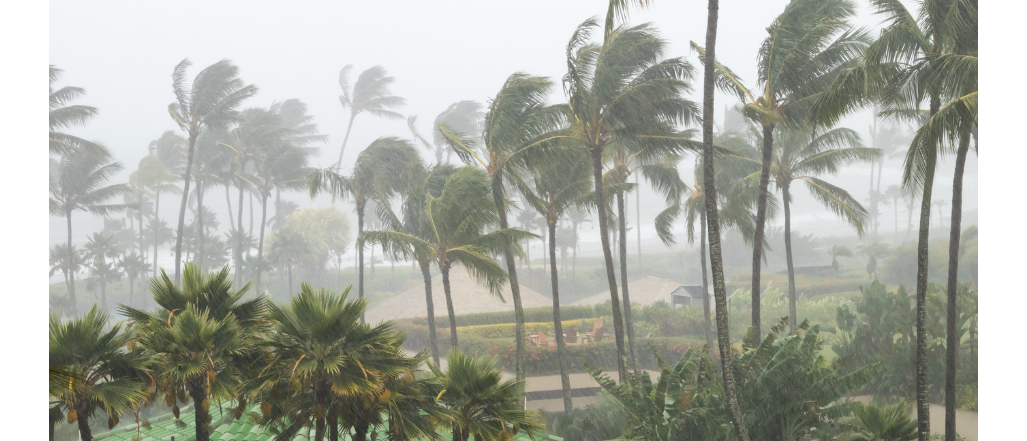Hurricanes can be life-threatening and cause billions of dollars in property damage. There are some parts of the country that are far more likely to see damaging hurricanes, so depending on where you live, knowing the threat level and what you can do to protect your home and auto is a wise idea.

Which areas of the U.S. are more susceptible to hurricanes?
The southeast and the states that border the Gulf of Mexico are the most susceptible to hurricanes, due to two major factors—warm ocean waters and wind direction. That said, any state that has Atlantic coastline is vulnerable, as the same factors of warm ocean water and wind direction apply.
The vast majority of hurricanes that can impact the U.S. form in the North Atlantic basin, a geographical area of open ocean located north of the equator, in between the U.S. and Africa. When areas of low pressure begin to move over ocean waters warmed by the summer sun, this creates the conditions for strong storms.
It’s important to note as Hurricane Hilary demonstrated in August 2023, hurricanes can even hit on the Pacific side of the U.S., but this is rare.
When is hurricane season?
Hurricane season starts on June 1 and runs through to November 30, but of course weather patterns aren’t bound by the calendar—named storms have formed both before and after this six-month window. It’s still a pretty accurate gauge, with the Atlantic Oceanographic and Meteorological Laboratory (AOML) estimating just over 97 percent of Atlantic tropical cyclone activity occurs within this window of time.
What are the different levels of hurricanes?
When listening to weather reporting during hurricane season, you’ll hear a lot of different terms used to describe pressure systems forming over the Atlantic Ocean. The important thing to keep in mind is that a storm’s strength is key to how it is described. Once a tropical depression increases in wind strength to 39 miles an hour or more, it’s considered a tropical storm—and that’s when it gets a name.
Weather reports start focusing on areas of activity long before they reach the named storm stage. Here are the different levels of hurricanes:
Tropical depression
This is the first stage of a storm that has the potential to develop into a hurricane, with winds at 38 miles per hour.
Tropical storm
When winds from a tropical depression increase to at least 39 miles per hour, that is when it is recategorized as a tropical storm.
Hurricane
If a tropical storm continues to strengthen and wind speeds increase to 74 miles an hour or more, it is then recategorized again as a hurricane.
Hurricane intensity
Once a named storm has wind speeds of 74 miles an hour, it is measured on the Saffir-Simpson scale, which assigns an intensity rating from 1 (74-95 mph sustained wind speed) to 5 (157 mph or higher wind speeds). A hurricane numbered three or higher on the Saffir-Simpson scale is considered to be a major hurricane.
In addition to the different levels of hurricanes, if you are in a region that is in the path of a hurricane or tropical storm, weather reports will likely contain mentions of either watches or warnings. As a reminder, here’s what each means:
- Tropical Storm or Hurricane watch – a watch is issued when a storm system may pose a threat to coastal areas.
- Tropical Storm or Hurricane warning – a warning is issued when a storm is approaching and is predicted to reach landfall in a coastal area within 24 hours.
Does homeowners insurance cover hurricane damage?
Homeowners insurance does often cover damage done by high winds, but it’s very important to check your policy and see if you are in a state or area that requires separate, additional coverage for damage done by hurricanes and tropical storms.
States with Atlantic coastline are more likely than not to require homeowners to carry specialized hurricane insurance—according to the Insurance Information Institute (III), nineteen states and the District of Columbia have hurricane deductibles: Alabama, Connecticut, Delaware, Florida, Georgia, Hawaii, Louisiana, Maine, Maryland, Massachusetts, Mississippi, New Jersey, New York, North Carolina, Pennsylvania, Rhode Island, South Carolina, Texas, Virginia, and D.C. Every state on the list except for Hawaii is located along either the Atlantic or Gulf Coast.
Hurricane deductibles have very specific parameters. For instance, there is typically a “trigger” that causes hurricane coverage to apply. Your policy will carry the details of what this is for your coverage, but examples are when a tropical depression crosses the threshold to being a tropical storm and receives a name. Typically, time is also a factor—such as coverage applying to damage that occurs within a range of hours or days before and after a named storm makes landfall.
Wind damage deductibles are part of most homeowners insurance policies, and can cover non-hurricane related wind damage, such as a hailstorm or strong thunderstorm. Hurricane deductibles are typically restricted to hurricane damage.
Even if you do carry separate hurricane coverage, make sure you understand the water damage provisions of your policy. Flood damage as a result of storm surges or water rising from a hurricane is almost never included—you’ll need a separate flood insurance policy for that.
Does auto insurance cover hurricane damage?
Whether your auto insurance policy covers hurricane damage depends on what you’ve purchased. If you have comprehensive auto insurance, you’re covered for damage to your vehicle that is caused by weather—including hurricanes. If you are only carrying liability coverage, or liability and collision, the damage done by a hurricane will not be covered.
Does flood insurance cover hurricane damage?
It’s important to understand the policy limits in your flood insurance. The National Flood Insurance Program (NFIP) notes that wind-driven rain that does damage to your home is not covered by your flood insurance. There are also maximum dollar limits to flood insurance coverage that may be far less than you’d need to fully recover from flood damage caused by a hurricane.
Take the time to know and understand all of the limits of your hurricane and flood coverage.

Where can I get a quote for additional homeowners insurance coverage?
If you live anywhere along the Eastern Seaboard of the U.S., it’s important to understand hurricane insurance—what is and is not included, and how a separate flood insurance policy might be a wise investment, even if you don’t live in a flood zone.
The experts at Guaranteed Rate Insurance will take the time to explain all of your options and find the best policy that fits your needs at the best price.
Disclaimer:
All information provided in this publication is for informational and educational purposes only, and in no way is any of the content contained herein to be construed as financial, investment, or legal advice or instruction. Guaranteed Rate Insurance does not guarantee the quality, accuracy, completeness or timelines of the information in this publication. While efforts are made to verify the information provided, the information should not be assumed to be error free. Some information in the publication may have been provided by third parties and has not necessarily been verified by Guaranteed Rate Insurance. Guaranteed Rate Insurance, its affiliates and subsidiaries do not assume any liability for the information contained herein, be it direct, indirect, consequential, special, or exemplary, or other damages whatsoever and howsoever caused, arising out of or in connection with the use of this publication or in reliance on the information, including any personal or pecuniary loss, whether the action is in contract, tort (including negligence) or other tortious action.

